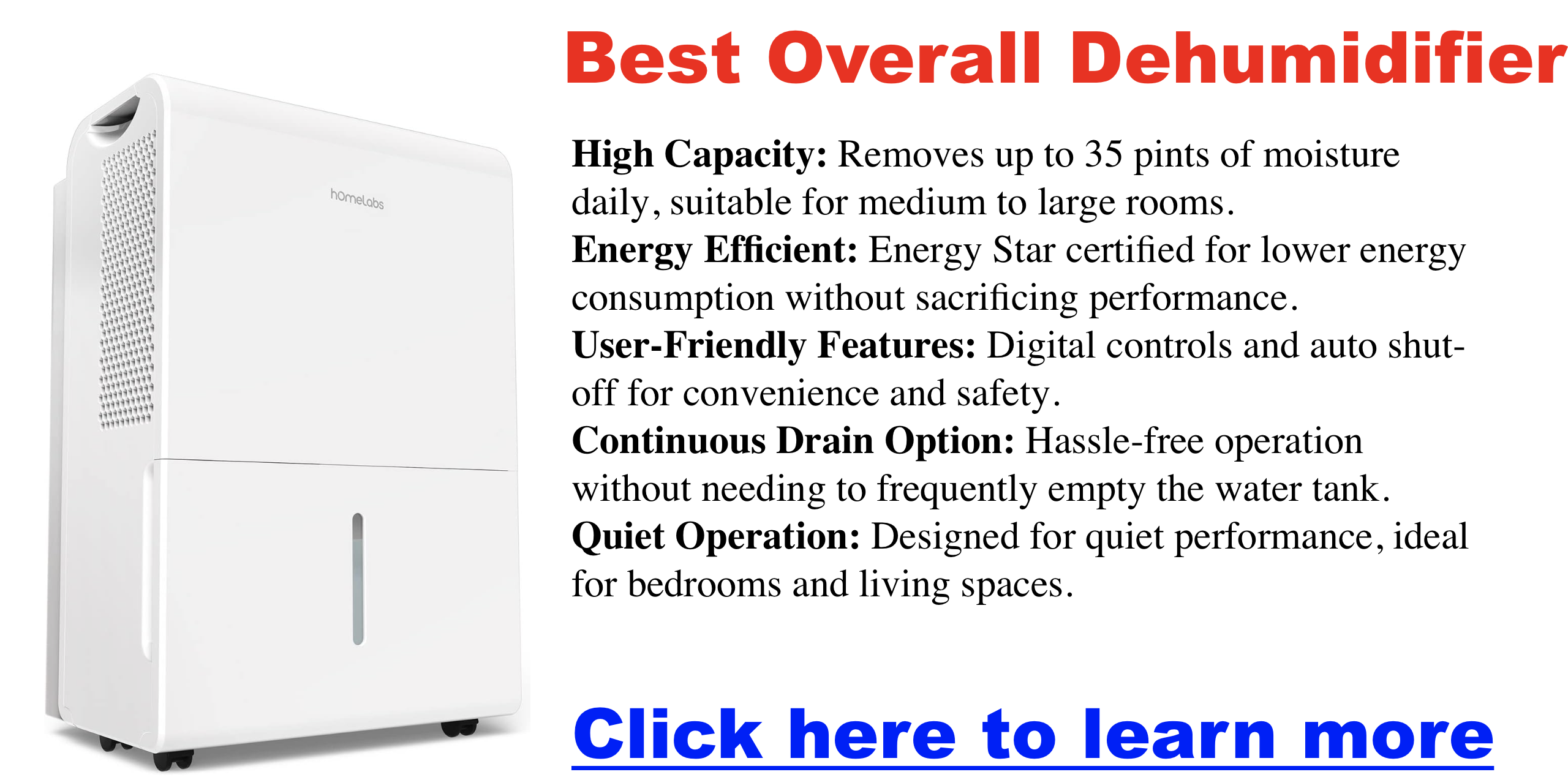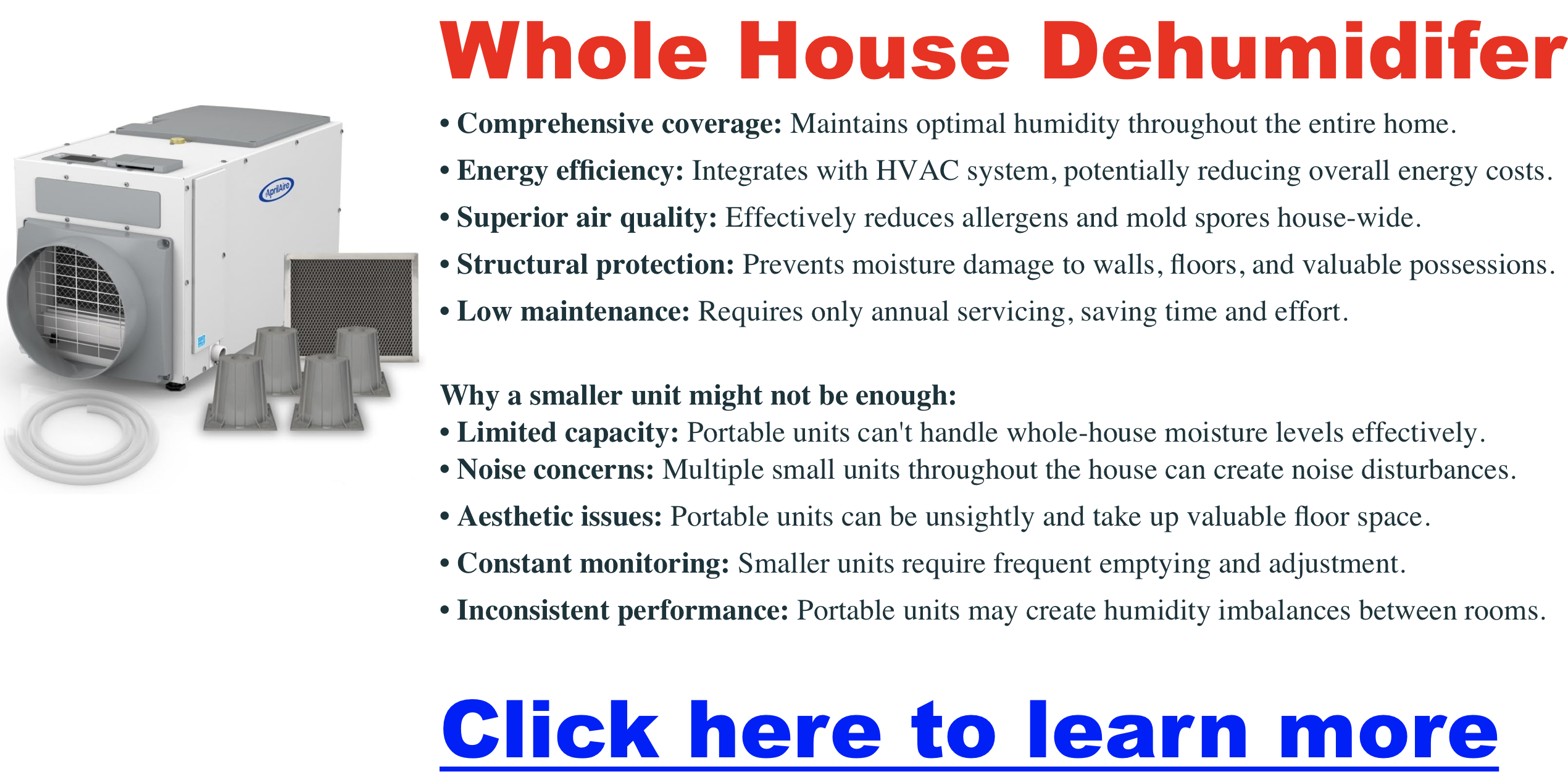Best Dehumidifiers For a House: Bedroom, Basement, and More
Maintaining the right humidity levels in a home is good for both comfort and health. High humidity can lead to mold growth, mildew, and allergens like dust mites, all of which can exacerbate allergies and respiratory problems. Dehumidifiers help keep these issues at bay, ensuring a comfortable and safe living environment. However, the right dehumidifier for a bedroom may not be the best option for a basement or a whole house. In this guide, we’ll break down the best dehumidifiers for every space and key considerations to help you make an informed choice.
Dehumidifier Size and Capacity: Choosing the Right Model
Regarding dehumidifiers, one of the most critical factors is capacity—how much moisture the unit can remove in a day, measured in pints. While many guides offer sizing charts based on room size, experts often recommend buying the largest capacity dehumidifier you can afford, especially a 50-pint unit. Here’s why:
- Faster Moisture Removal: A 50-pint dehumidifier can remove moisture faster than smaller 35- or 22-pint models, which is particularly important in high-humidity areas.
- Increased Lifespan: Since larger units remove moisture more quickly, they run less frequently, putting less stress on the internal components. This means they often last longer.
- Energy Efficiency: While a larger unit may seem overkill for a small room, it can be more energy-efficient in the long run by minimizing running time.
A smaller unit may suffice if you’re dealing with a small space or live in a dry climate. However, investing in a larger capacity dehumidifier is the most efficient option for most environments.
Best Dehumidifiers for Bedrooms
When choosing a dehumidifier for your bedroom, quiet operation should be a top priority. After all, no one wants to be kept awake by a machine’s constant hum.
Key Features for Bedroom Dehumidifiers:
- Low Noise Operation: To minimize disturbance, look for units with lower fan speeds and quiet compressors.
- Ease of Maintenance: Bedroom dehumidifiers may need to be emptied frequently depending on humidity levels. Features like easy-to-empty water tanks and full-tank indicators can make maintenance much simpler.
- Smart Features: If convenience is a priority, consider a Wi-Fi connectivity model allowing you to monitor and control the dehumidifier remotely.
| Brand and Model | Capacity (pints/day) | Features |
|---|---|---|
| Insignia NS-DH35WH1 35 Pint Dehumidifier | 35 |
|
| Frigidaire FFAD2233W1 | 22 |
|
| Eva-Dry Electric Petite Dehumidifier | – |
|
Dehumidifiers for the Whole House
If you need to control humidity throughout your entire house, a large-capacity dehumidifier is your best bet.
Key Considerations for Whole-House Dehumidifiers:
- Continuous Drainage: For whole-house units, a continuous drain hose is essential, allowing the dehumidifier to operate without needing to empty the water tank.
- Airflow: Ensure the layout of your home allows for good air circulation, as this affects the unit’s ability to dehumidify effectively across rooms.
- Energy Efficiency: Larger units tend to be more energy-efficient since they dehumidify faster and run less frequently.
Key Benefits of Whole-House Dehumidifiers
Whole-house dehumidifiers offer an efficient, low-maintenance solution to control your home’s humidity levels. Here’s why they’re worth considering:
- Improved Comfort & Health: These systems maintain optimal humidity (30-50%), helping eliminate that sticky feeling caused by excess moisture.
- Cleaner Air: Whole-house units regulate humidity and filter out allergens like pollen and dust, contributing to fresher, cleaner air throughout your home.
- Energy Efficiency: They reduce the strain on your HVAC system, allowing it to run more efficiently.
- Protects Home & Belongings: Excess moisture can damage wood, paint, and furniture.
- Low Maintenance & Quiet Operation: These units are connected to your HVAC system, automatically draining collected moisture. They are discreet, tucked away in basements, and operate quietly without needing constant attention.
| Model | Moisture Removal (Pints/Day) | Coverage (Sq Ft) | Features | Price Range |
|---|---|---|---|---|
| AprilAire E100 Pro | 100 | Up to 5,500 | Energy-efficient, corrosion-resistant, automatic on/off | $1,000 – $3,000 |
| Ivation 70-Pint with Pump | 70 | Up to 4,500 | Auto shutoff, frost sensor, continuous use with pump | $400 – $700 |
| AprilAire E080 Pro | 80 | Up to 4,400 | Quiet operation, automatic controls | $1,500 – $2,500 |
| Santa Fe Ultra98 | 98 | Whole house | Excellent air filtration, Energy Star certified | $2,000 – $3,000 |
| Honeywell Ducted 88-Pint | 88 | Whole house | Energy-efficient, ducted installation, minimal noise | $1,500 – $2,500 |
| AprilAire E070 Pro (Crawl Space) | 70 | Crawl spaces | Designed for tight spaces, durable and efficient | $1,000 – $2,000 |
Dehumidifiers for Basements
Basements tend to be the dampest areas of a home, often requiring the most powerful dehumidifiers. A pump-equipped unit is particularly useful in a basement, as it allows water to be drained into sinks or other drainage points located above the dehumidifier.
Pump vs. Gravity Drainage:
- Built-in Pump: This feature is convenient but can sometimes fail over time. If reliability is a concern, consider purchasing a high-quality external pump and pairing it with a dehumidifier that has a gravity drain outlet.
| Brand and Model | Capacity (pints/day) | Pump Type | Key Features |
|---|---|---|---|
| Whynter Energy Star Portable Dehumidifier with Pump | 50 | Built-in |
|
| Midea Cube with Pump (MAD50PS1QWT) | 50 | Built-in |
|
| Any Dehumidifier with Gravity Drain + External Condensate Pump | Varies | External (Separate Purchase) |
|
Dehumidifier FAQ: Common Questions Answered
What is the best dehumidifier capacity for my needs?
A 50-pint dehumidifier is ideal for most spaces. It removes moisture faster and lasts longer due to less frequent operation. A smaller unit may suffice if you have a small space or live in a dry climate, but a larger capacity is generally more efficient.
What size water tank should I get?
Water tank size depends on the room’s humidity and how often you’re willing to empty it. Larger tanks require less frequent emptying, but for convenience, choose a model with continuous drainage to eliminate manual tank emptying.
Do I need a built-in pump?
If your dehumidifier can’t be placed near a floor drain, a built-in pump allows water to be drained into a sink or higher location, providing flexibility in where you can place the unit.
What are the benefits of a smart dehumidifier?
Smart dehumidifiers, with Wi-Fi connectivity, allow you to control and monitor humidity levels remotely. You can set schedules, receive alerts, and track humidity levels from your phone, making them incredibly convenient for busy households.
What are the quietest dehumidifiers?
Quiet operation depends on factors like fan speed, exhaust direction, and compressor noise. Models with side exhausts and quieter compressors, like the Insignia NS-DH35WH1, are typically perceived as quieter.
Which dehumidifiers are the most energy-efficient?
Larger units are generally more energy-efficient, as they dehumidify faster, reducing overall run time. The Midea Cube is a highly rated, energy-efficient 50-pint unit.
How do I maintain my dehumidifier?
Regular maintenance is key to optimal performance. Clean the filter, empty the water tank, or set up continuous drainage. If you notice frost buildup in colder environments, defrost the unit as instructed.
Other Features to Consider
- Energy Star Certification: Look for this label to ensure your dehumidifier is energy-efficient and will help reduce electricity costs.
- Humidistat and Auto Features: A humidistat allows you to set and maintain your desired humidity level. Features like automatic defrost and auto-restart enhance performance and convenience, especially in colder climates.
- Portability: If you need to move the dehumidifier between rooms, look for models with wheels or easy-to-carry handles.
Conclusion
Choosing the right dehumidifier depends on your space’s specific needs. Whether you’re looking for a quiet dehumidifier for your bedroom, a powerful unit for your basement, or a large-capacity model for whole-house control, the key is to match the unit’s capacity and features to your home’s environment. Remember to consider factors like noise level, water tank size, and convenience features like smart controls or built-in pumps.
- Why Your Septic Tank Smells When It Rains (and What to Do About It)
- How to Handle Water-Damaged Wood in Your Home or Business
- How to Prevent and Remove Mold from Pillows: A Complete Guide
- Why Is My Carpet Always Wet? A Step-by-Step Guide to Identifying the Source of Moisture
- Signs of Septic System Failure and What It Means for Your Basement

